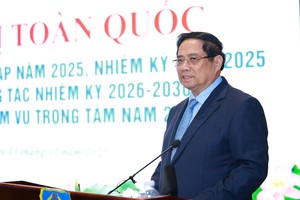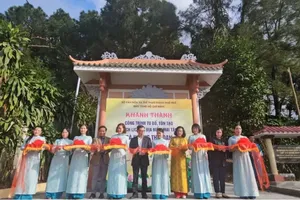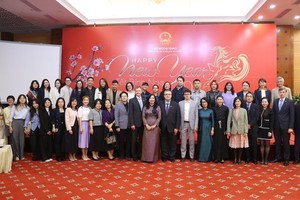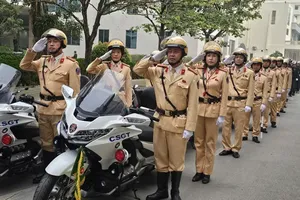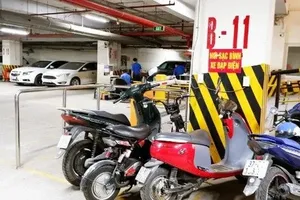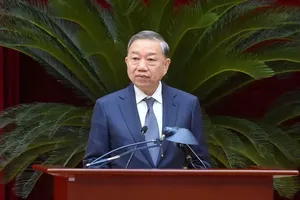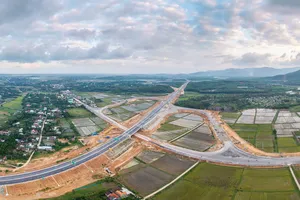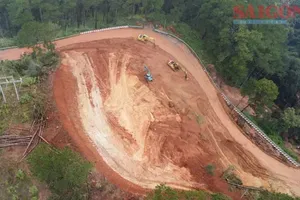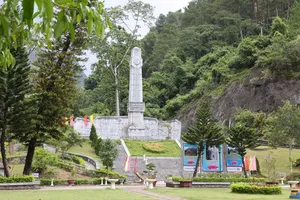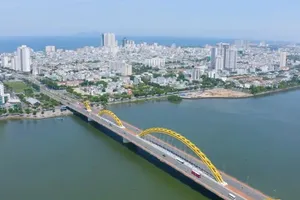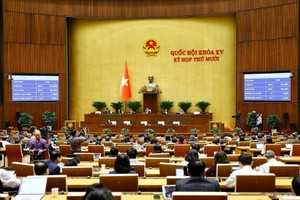 Passengers check in at Hanoi Railway Station. (Photo: SGGP)
Passengers check in at Hanoi Railway Station. (Photo: SGGP)
Not exploiting the full capacity
On the SE8 train from HCMC to Hanoi on November 3, according to the reporter of the SGGP Newspaper, rail car No.2 has 52 seats but only has ten passengers, and the rest are empty seats. Bui Hoang Nam, an employee at Bien Hoa Railway Station, said that since reopening to now, the number of passengers was very small. Currently, three trains pass Bien Hoa Railway Station every day, but only more than 60 passengers board these trains.
Mr. Nguyen Van Son, Head of train SE8, said that his train has eight passenger train cars and four freight train cars. Eight passenger train cars have a capacity of about 300 passengers with both beds and seats. However, these train cars currently operate at only 40 percent of passengers compared to the capacity. During its route through stations, an additional 10 percent of passengers board the train. Freight train cars are rarely fully occupied. Recently, the number of passengers traveling by train in general and the route from HCMC to Nha Trang, in particular, has decreased sharply because it cannot compete with other modes of transport.
The Hanoi - Vinh railway line has a length of 319km. Ms. Phung Thi Ly Ha, Deputy Director of Hanoi Railway Transport Company, said that in the past, on the occasion of national holidays, besides four pairs of North-South trains that stop at Vinh Railway Station and two trains of the Hanoi - Vinh route that run regularly, the railway industry had to set up 4-5 more trains, with a capacity of about 400 passengers per train, to carry passengers on this route. Now, this railway line barely operates at full capacity. On average, the number of passengers on this route reaches about 6,000-7,000 passengers per day.
Low profitability forecast
According to calculations in the research report on the high-speed railway projects of Hanoi - Vinh and HCMC - Nha Trang chaired by the Japan International Cooperation Agency (JICA) and the Vietnam Railways Corporation, the total cost is US$10.2 billion for the Hanoi - Vinh section and $9.9 billion for the HCMC - Nha Trang section. Construction unit cost is $35 million per kilometer for the Northern section and $27.1 million per kilometer for the Southern one. The investment cost for vehicles is $1 billion for both routes.
Noticeably, this study also predicts that in 2030, railway passenger demand for the Hanoi - Vinh route will only be about 9,000 passengers per day if exploiting the existing railway route and about 14,000 passengers per day for the high-speed one. Thus, the financial internal rate of return (FIRR) of the project is extremely low, at minus 10.96 percent.
Assessing the feasibility of investment in these two projects, according to Mr. Vu Anh Minh, Chairman of the Vietnam Railways Corporation, it is best to invest in the Hanoi - HCMC route. “If dividing the investment, I only agree with the HCMC - Nha Trang and Hanoi - Da Nang sections. It must be the Hanoi - Da Nang route instead of the Hanoi – Vinh because the passenger traffic from Hanoi to Da Nang is much larger than from Hanoi to Vinh. Then the efficiency of the high-speed railway can be promoted and meet the design capacity. The Hanoi - Vinh route easily encounters failure because, with a frequency of 50 train trips per day, the route will only reach 20 percent of the design capacity," said Mr. Vu Anh Minh.
HCMC, Mekong Delta waiting for load reduction
The Mekong Delta is the origin of Vietnam's railway industry with the Saigon - My Tho railway route. However, after more than 100 years, the railway to the Mekong Delta is only a memory.
Mr. Nguyen Ngoc He, Vice Chairman of Can Tho City People's Committee, said that at present, the transport system connecting the Mekong Delta with HCMC was overloaded. Roads had not been synchronously invested, the waterways had not brought into full play their advantages, and the logistics system was weak, leading to high transportation costs. Meanwhile, growth in freight and passenger transport activities in the Mekong Delta region has been increasing ceaselessly. Therefore, prioritizing investment in the HCMC - Can Tho railway route is an urgent need.
The export demand for the three main commodities, namely aquatic products, rice, and fruits of the Mekong Delta, is extremely high, estimated at 17-18 million tons per year and constantly increasing by an average of 10-15 percent per year. The establishment and operation of the HCMC - Can Tho railway will contribute to promoting trade and travel activities between HCMC and the Mekong Delta.
According to Mr. Nguyen Anh Tuan, a lecturer at the HCMC University of Transport, it is estimated that the cost for the HCMC - Can Tho high-speed railway line is about $10 billion, nearly equal to the investment budget for the Hanoi - Vinh route.
On the SE8 train from HCMC to Hanoi on November 3, according to the reporter of the SGGP Newspaper, rail car No.2 has 52 seats but only has ten passengers, and the rest are empty seats. Bui Hoang Nam, an employee at Bien Hoa Railway Station, said that since reopening to now, the number of passengers was very small. Currently, three trains pass Bien Hoa Railway Station every day, but only more than 60 passengers board these trains.
Mr. Nguyen Van Son, Head of train SE8, said that his train has eight passenger train cars and four freight train cars. Eight passenger train cars have a capacity of about 300 passengers with both beds and seats. However, these train cars currently operate at only 40 percent of passengers compared to the capacity. During its route through stations, an additional 10 percent of passengers board the train. Freight train cars are rarely fully occupied. Recently, the number of passengers traveling by train in general and the route from HCMC to Nha Trang, in particular, has decreased sharply because it cannot compete with other modes of transport.
The Hanoi - Vinh railway line has a length of 319km. Ms. Phung Thi Ly Ha, Deputy Director of Hanoi Railway Transport Company, said that in the past, on the occasion of national holidays, besides four pairs of North-South trains that stop at Vinh Railway Station and two trains of the Hanoi - Vinh route that run regularly, the railway industry had to set up 4-5 more trains, with a capacity of about 400 passengers per train, to carry passengers on this route. Now, this railway line barely operates at full capacity. On average, the number of passengers on this route reaches about 6,000-7,000 passengers per day.
Low profitability forecast
According to calculations in the research report on the high-speed railway projects of Hanoi - Vinh and HCMC - Nha Trang chaired by the Japan International Cooperation Agency (JICA) and the Vietnam Railways Corporation, the total cost is US$10.2 billion for the Hanoi - Vinh section and $9.9 billion for the HCMC - Nha Trang section. Construction unit cost is $35 million per kilometer for the Northern section and $27.1 million per kilometer for the Southern one. The investment cost for vehicles is $1 billion for both routes.
Noticeably, this study also predicts that in 2030, railway passenger demand for the Hanoi - Vinh route will only be about 9,000 passengers per day if exploiting the existing railway route and about 14,000 passengers per day for the high-speed one. Thus, the financial internal rate of return (FIRR) of the project is extremely low, at minus 10.96 percent.
Assessing the feasibility of investment in these two projects, according to Mr. Vu Anh Minh, Chairman of the Vietnam Railways Corporation, it is best to invest in the Hanoi - HCMC route. “If dividing the investment, I only agree with the HCMC - Nha Trang and Hanoi - Da Nang sections. It must be the Hanoi - Da Nang route instead of the Hanoi – Vinh because the passenger traffic from Hanoi to Da Nang is much larger than from Hanoi to Vinh. Then the efficiency of the high-speed railway can be promoted and meet the design capacity. The Hanoi - Vinh route easily encounters failure because, with a frequency of 50 train trips per day, the route will only reach 20 percent of the design capacity," said Mr. Vu Anh Minh.
HCMC, Mekong Delta waiting for load reduction
The Mekong Delta is the origin of Vietnam's railway industry with the Saigon - My Tho railway route. However, after more than 100 years, the railway to the Mekong Delta is only a memory.
Mr. Nguyen Ngoc He, Vice Chairman of Can Tho City People's Committee, said that at present, the transport system connecting the Mekong Delta with HCMC was overloaded. Roads had not been synchronously invested, the waterways had not brought into full play their advantages, and the logistics system was weak, leading to high transportation costs. Meanwhile, growth in freight and passenger transport activities in the Mekong Delta region has been increasing ceaselessly. Therefore, prioritizing investment in the HCMC - Can Tho railway route is an urgent need.
The export demand for the three main commodities, namely aquatic products, rice, and fruits of the Mekong Delta, is extremely high, estimated at 17-18 million tons per year and constantly increasing by an average of 10-15 percent per year. The establishment and operation of the HCMC - Can Tho railway will contribute to promoting trade and travel activities between HCMC and the Mekong Delta.
According to Mr. Nguyen Anh Tuan, a lecturer at the HCMC University of Transport, it is estimated that the cost for the HCMC - Can Tho high-speed railway line is about $10 billion, nearly equal to the investment budget for the Hanoi - Vinh route.
